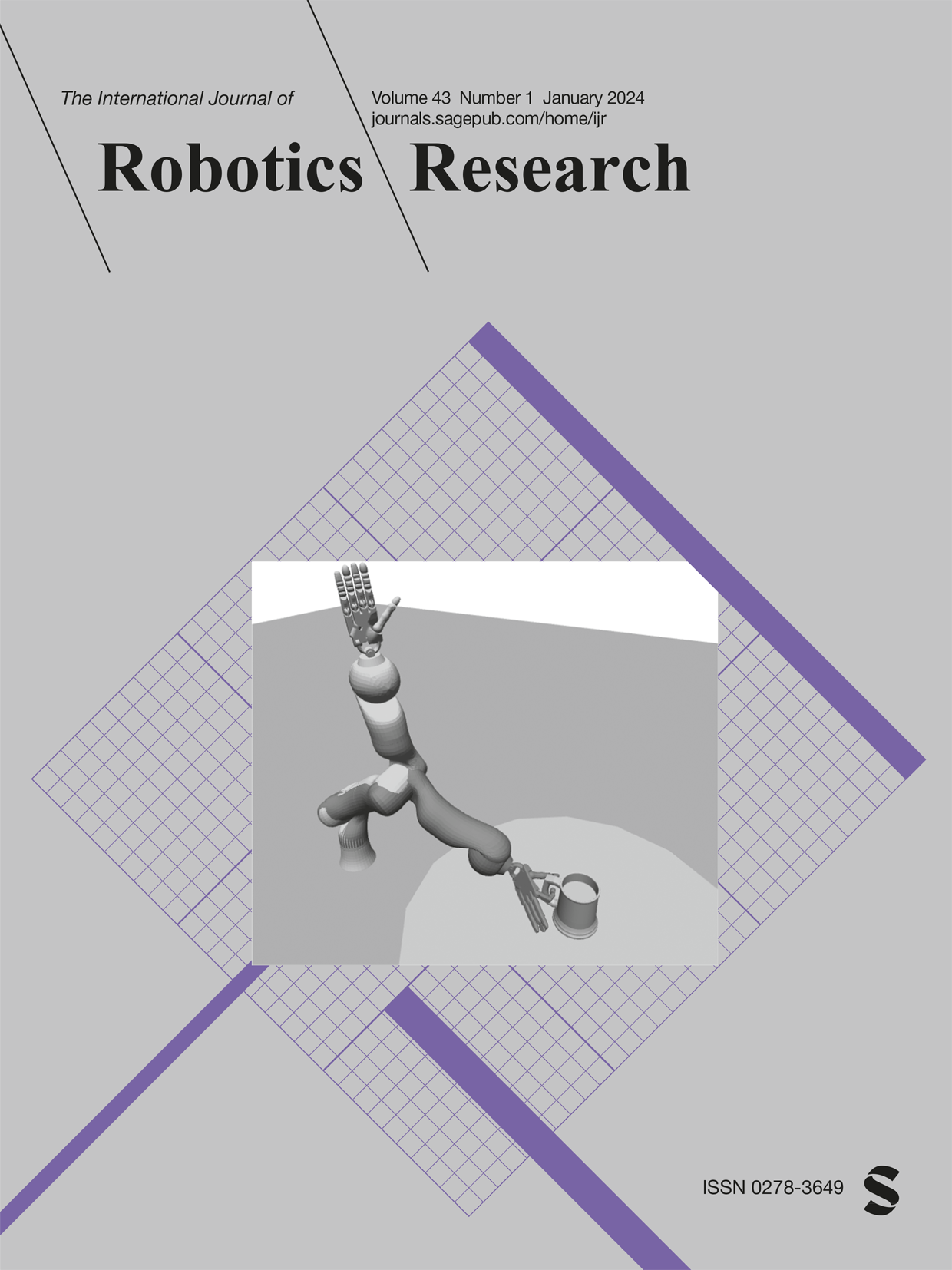无碰撞位形空间的认证多面体分解
IF 5
1区 计算机科学
Q1 ROBOTICS
引用次数: 0
摘要
在笛卡尔空间障碍物存在的情况下,了解无碰撞构型空间(C-free)的几何形状是无碰撞运动规划的重要组成部分。虽然可以使用标准算法来检查一点上的碰撞,但由于通过运动学映射笛卡尔空间障碍物的复杂性,迄今为止还没有实用的方法来计算具有严格证书的C-free区域。在这项工作中,我们提出了我们所知的第一个严格的方法来近似分解C-free的合理参数化为认证的多面体区域。我们的方法,称为C-Iris (C-space Iterative Regional Inflation by半确定规划),在构型空间的合理参数化中生成大型凸多面体,并被严格证明为无碰撞。这些区域已被证明对基于优化和随机运动规划都是有用的。该方法基于凸优化,适用于任意维度,仅对三维笛卡尔空间中障碍物的凹凸性进行假设,并且速度足够快,可以扩展到实际操作问题。我们在几个2自由度的例子中展示了我们的算法填充大量无碰撞c空间的能力,其中c空间可以可视化,以及我们的算法在7自由度KUKA iiwa, 6自由度UR3e和12自由度手动机械手上的可扩展性。我们算法的实现在Drake中是开源的。我们还在交互式Python笔记本中提供了我们算法的示例。本文章由计算机程序翻译,如有差异,请以英文原文为准。
Certified polyhedral decompositions of collision-free configuration space
Understanding the geometry of collision-free configuration space (C-free) in the presence of Cartesian-space obstacles is an essential ingredient for collision-free motion planning. While it is possible to check for collisions at a point using standard algorithms, to date no practical method exists for computing C-free regions with rigorous certificates due to the complexity of mapping Cartesian-space obstacles through the kinematics. In this work, we present the first to our knowledge rigorous method for approximately decomposing a rational parametrization of C-free into certified polyhedral regions. Our method, called C-Iris (C-space Iterative Regional Inflation by Semidefinite programming), generates large, convex polytopes in a rational parameterization of the configuration space which are rigorously certified to be collision-free. Such regions have been shown to be useful for both optimization-based and randomized motion planning. Based on convex optimization, our method works in arbitrary dimensions, only makes assumptions about the convexity of the obstacles in the 3D Cartesian space, and is fast enough to scale to realistic problems in manipulation. We demonstrate our algorithm’s ability to fill a non-trivial amount of collision-free C-space in several 2-DOF examples where the C-space can be visualized, as well as the scalability of our algorithm on a 7-DOF KUKA iiwa, a 6-DOF UR3e, and 12-DOF bimanual manipulators. An implementation of our algorithm is open-sourced in Drake . We furthermore provide examples of our algorithm in interactive Python notebooks .
求助全文
通过发布文献求助,成功后即可免费获取论文全文。
去求助
来源期刊
CiteScore
22.20
自引率
0.00%
发文量
34
审稿时长
6-12 weeks
期刊介绍:
The International Journal of Robotics Research (IJRR) has been a leading peer-reviewed publication in the field for over two decades. It holds the distinction of being the first scholarly journal dedicated to robotics research.
IJRR presents cutting-edge and thought-provoking original research papers, articles, and reviews that delve into groundbreaking trends, technical advancements, and theoretical developments in robotics. Renowned scholars and practitioners contribute to its content, offering their expertise and insights. This journal covers a wide range of topics, going beyond narrow technical advancements to encompass various aspects of robotics.
The primary aim of IJRR is to publish work that has lasting value for the scientific and technological advancement of the field. Only original, robust, and practical research that can serve as a foundation for further progress is considered for publication. The focus is on producing content that will remain valuable and relevant over time.
In summary, IJRR stands as a prestigious publication that drives innovation and knowledge in robotics research.

 求助内容:
求助内容: 应助结果提醒方式:
应助结果提醒方式:


